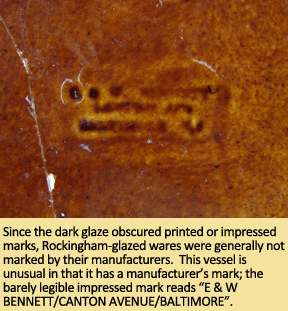Baltimore Rockingham Hunt Pitcher
May 2012
By Patricia Samford, MAC Lab Director
In the mid- to late nineteenth century, the neighborhood west of Baltimore's Inner Harbor was typical of the city's mixed business and working class residential areas and often home to first and second generation European immigrants. Residents lived in row houses that fronted directly onto the city streets and included tiny backyards containing privies, henhouses, wells and work yards.
During the 1980 archaeological excavation done prior to the construction of the Federal Reserve Bank, archaeologists excavated the contents of a number of these wells and privy pits. One of these privies had become the final resting place for a magnificent example of Baltimore’s nineteenth-century pottery industry. Although discovered in numerous pieces, the pitcher was mended by lab technician Erin Wingfield, restoring this vessel to much of its former glory.

This Rockingham pitcher, molded in a detailed hunting scene depicting hounds attacking a stag and a boar, was manufactured around 1855 by E. & W. Bennett of Baltimore (Claney 2004). Edwin Bennett's firm, in production between 1846 and 1936, was one of the best known North American manufacturers of Rockingham glazed wares (Ketchum 1987:21). This firm’s wares are known for their finely detailed molded patterns, as well as quality of their mottled glazing (Brooks 2005).
 Rockingham glazed vessels were inexpensive, mass-produced wares of the mid-nineteenth to the early twentieth centuries, manufactured in both England and North America (Claney 2004). Characterized by brown mottled and streaked glaze, Rockingham wares were often molded with elaborate designs, incorporating naturalistic motifs with vines, corn, flowers, grapes, and seashells. Rockingham glazes adorned a variety of vessel forms for kitchen, dining and ornamental use, including pitchers, teapots, mugs, bowls, candlesticks, coffee pots, doorknobs and spittoons. Perhaps the iconic Rockingham vessel is the "Rebekah at the Well" teapot, molded with a scene of a woman holding a jug at an open well. Introduced by Edwin Bennett in 1851, this pattern quickly became popular and was produced by numerous manufacturers (Claney 2004:81, Liebeknecht 2000).
Rockingham glazed vessels were inexpensive, mass-produced wares of the mid-nineteenth to the early twentieth centuries, manufactured in both England and North America (Claney 2004). Characterized by brown mottled and streaked glaze, Rockingham wares were often molded with elaborate designs, incorporating naturalistic motifs with vines, corn, flowers, grapes, and seashells. Rockingham glazes adorned a variety of vessel forms for kitchen, dining and ornamental use, including pitchers, teapots, mugs, bowls, candlesticks, coffee pots, doorknobs and spittoons. Perhaps the iconic Rockingham vessel is the "Rebekah at the Well" teapot, molded with a scene of a woman holding a jug at an open well. Introduced by Edwin Bennett in 1851, this pattern quickly became popular and was produced by numerous manufacturers (Claney 2004:81, Liebeknecht 2000).
Pitchers with hunting motifs were viewed as appropriate gifts for men, serving to reinforce nineteenth-century concepts of masculinity (Claney 2004). This pitcher may have been used to serve beer—a beverage that was becoming popular at this time, particularly with the influx of German immigrants into Baltimore. Although Rockingham wares produced by E. & W. Bennett were doubtless sold all over North America, this pitcher never made it more than a mile from the factory where it was produced!
| References |
|
| Brooks, Lauren |
| 2005 |
The Story of Baltimore Pottery. Chesapeake Home. www.chesapeakehome.com/2005/08/11/collecting-antique-local-pottery/ Website accessed 12-5-2011. |
|
| Claney, Jane Perkins |
| 2004 |
Rockingham Ware in American Culture, 1830-1930; Reading Historical Artifacts. University Press of New England, Hanover. |
|
| Ketchum, William C., Jr. |
| 1987 |
American Country Pottery; Yellowware & Spongeware. Alfred Knopf, New York. |
|
| Liebeknecht, William B. |
| 2000 |
Joesph Mayer's Arsenal Pottery Dump. Part 1: Yellow ware. Trenton Potteries: Newsletter of the Potteries of Trenton Society. April/May 2000, Volume 1: Issue 2. |
|